Organizational Culture: Exploring Hofstede's Dimensions - Essay
VerifiedAdded on 2020/10/22
|6
|1304
|471
Essay
AI Summary
This essay delves into the concept of organizational culture, defining it as the shared values and beliefs that guide employee behavior within an organization. It examines Geert Hofstede's cultural dimensions, including individualism versus collectivism, power distance, uncertainty avoidance, and masculinity versus femininity, and their influence on business practices. The essay analyzes each dimension, providing examples and discussing their implications for global businesses. It critiques the dimensions, arguing for the benefits of collectivism and low uncertainty avoidance in fostering innovation and a positive work environment. The essay concludes with recommendations for organizations to adopt these cultural aspects to achieve greater employee engagement, trust, and overall success in the market.

Individual Essay
Paraphrase This Document
Need a fresh take? Get an instant paraphrase of this document with our AI Paraphraser
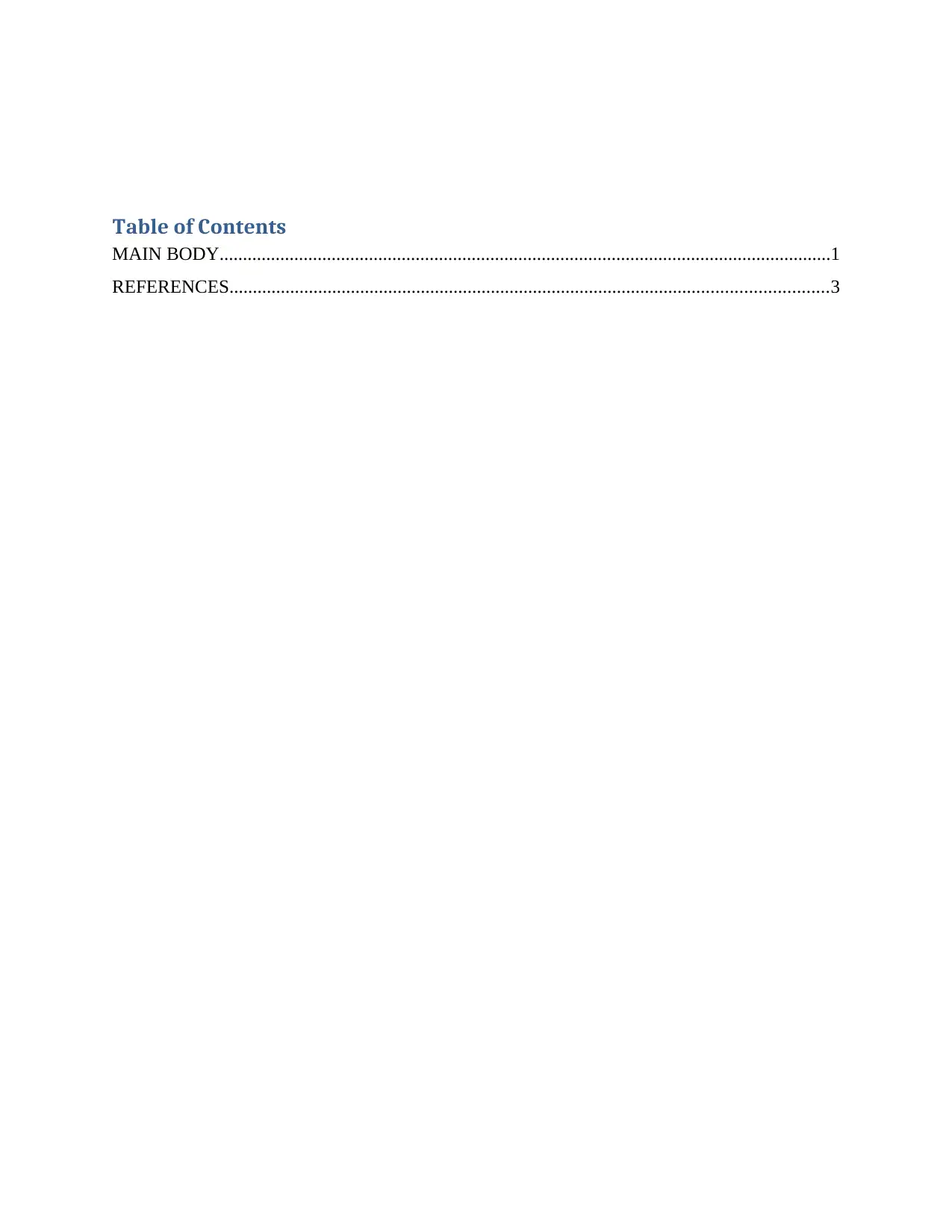
Table of Contents
MAIN BODY...................................................................................................................................1
REFERENCES................................................................................................................................3
MAIN BODY...................................................................................................................................1
REFERENCES................................................................................................................................3
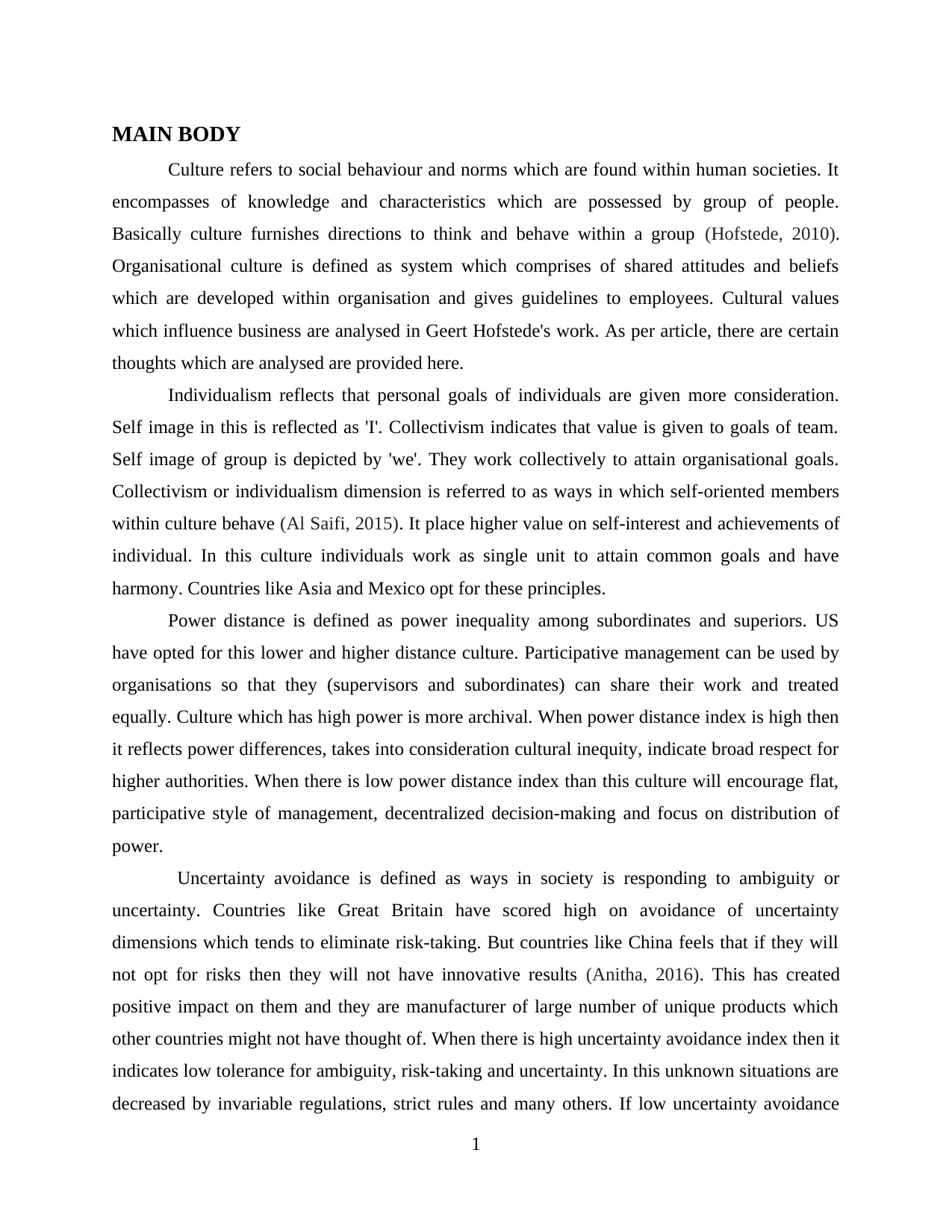
MAIN BODY
Culture refers to social behaviour and norms which are found within human societies. It
encompasses of knowledge and characteristics which are possessed by group of people.
Basically culture furnishes directions to think and behave within a group (Hofstede, 2010).
Organisational culture is defined as system which comprises of shared attitudes and beliefs
which are developed within organisation and gives guidelines to employees. Cultural values
which influence business are analysed in Geert Hofstede's work. As per article, there are certain
thoughts which are analysed are provided here.
Individualism reflects that personal goals of individuals are given more consideration.
Self image in this is reflected as 'I'. Collectivism indicates that value is given to goals of team.
Self image of group is depicted by 'we'. They work collectively to attain organisational goals.
Collectivism or individualism dimension is referred to as ways in which self-oriented members
within culture behave (Al Saifi, 2015). It place higher value on self-interest and achievements of
individual. In this culture individuals work as single unit to attain common goals and have
harmony. Countries like Asia and Mexico opt for these principles.
Power distance is defined as power inequality among subordinates and superiors. US
have opted for this lower and higher distance culture. Participative management can be used by
organisations so that they (supervisors and subordinates) can share their work and treated
equally. Culture which has high power is more archival. When power distance index is high then
it reflects power differences, takes into consideration cultural inequity, indicate broad respect for
higher authorities. When there is low power distance index than this culture will encourage flat,
participative style of management, decentralized decision-making and focus on distribution of
power.
Uncertainty avoidance is defined as ways in society is responding to ambiguity or
uncertainty. Countries like Great Britain have scored high on avoidance of uncertainty
dimensions which tends to eliminate risk-taking. But countries like China feels that if they will
not opt for risks then they will not have innovative results (Anitha, 2016). This has created
positive impact on them and they are manufacturer of large number of unique products which
other countries might not have thought of. When there is high uncertainty avoidance index then it
indicates low tolerance for ambiguity, risk-taking and uncertainty. In this unknown situations are
decreased by invariable regulations, strict rules and many others. If low uncertainty avoidance
1
Culture refers to social behaviour and norms which are found within human societies. It
encompasses of knowledge and characteristics which are possessed by group of people.
Basically culture furnishes directions to think and behave within a group (Hofstede, 2010).
Organisational culture is defined as system which comprises of shared attitudes and beliefs
which are developed within organisation and gives guidelines to employees. Cultural values
which influence business are analysed in Geert Hofstede's work. As per article, there are certain
thoughts which are analysed are provided here.
Individualism reflects that personal goals of individuals are given more consideration.
Self image in this is reflected as 'I'. Collectivism indicates that value is given to goals of team.
Self image of group is depicted by 'we'. They work collectively to attain organisational goals.
Collectivism or individualism dimension is referred to as ways in which self-oriented members
within culture behave (Al Saifi, 2015). It place higher value on self-interest and achievements of
individual. In this culture individuals work as single unit to attain common goals and have
harmony. Countries like Asia and Mexico opt for these principles.
Power distance is defined as power inequality among subordinates and superiors. US
have opted for this lower and higher distance culture. Participative management can be used by
organisations so that they (supervisors and subordinates) can share their work and treated
equally. Culture which has high power is more archival. When power distance index is high then
it reflects power differences, takes into consideration cultural inequity, indicate broad respect for
higher authorities. When there is low power distance index than this culture will encourage flat,
participative style of management, decentralized decision-making and focus on distribution of
power.
Uncertainty avoidance is defined as ways in society is responding to ambiguity or
uncertainty. Countries like Great Britain have scored high on avoidance of uncertainty
dimensions which tends to eliminate risk-taking. But countries like China feels that if they will
not opt for risks then they will not have innovative results (Anitha, 2016). This has created
positive impact on them and they are manufacturer of large number of unique products which
other countries might not have thought of. When there is high uncertainty avoidance index then it
indicates low tolerance for ambiguity, risk-taking and uncertainty. In this unknown situations are
decreased by invariable regulations, strict rules and many others. If low uncertainty avoidance
1
⊘ This is a preview!⊘
Do you want full access?
Subscribe today to unlock all pages.

Trusted by 1+ million students worldwide
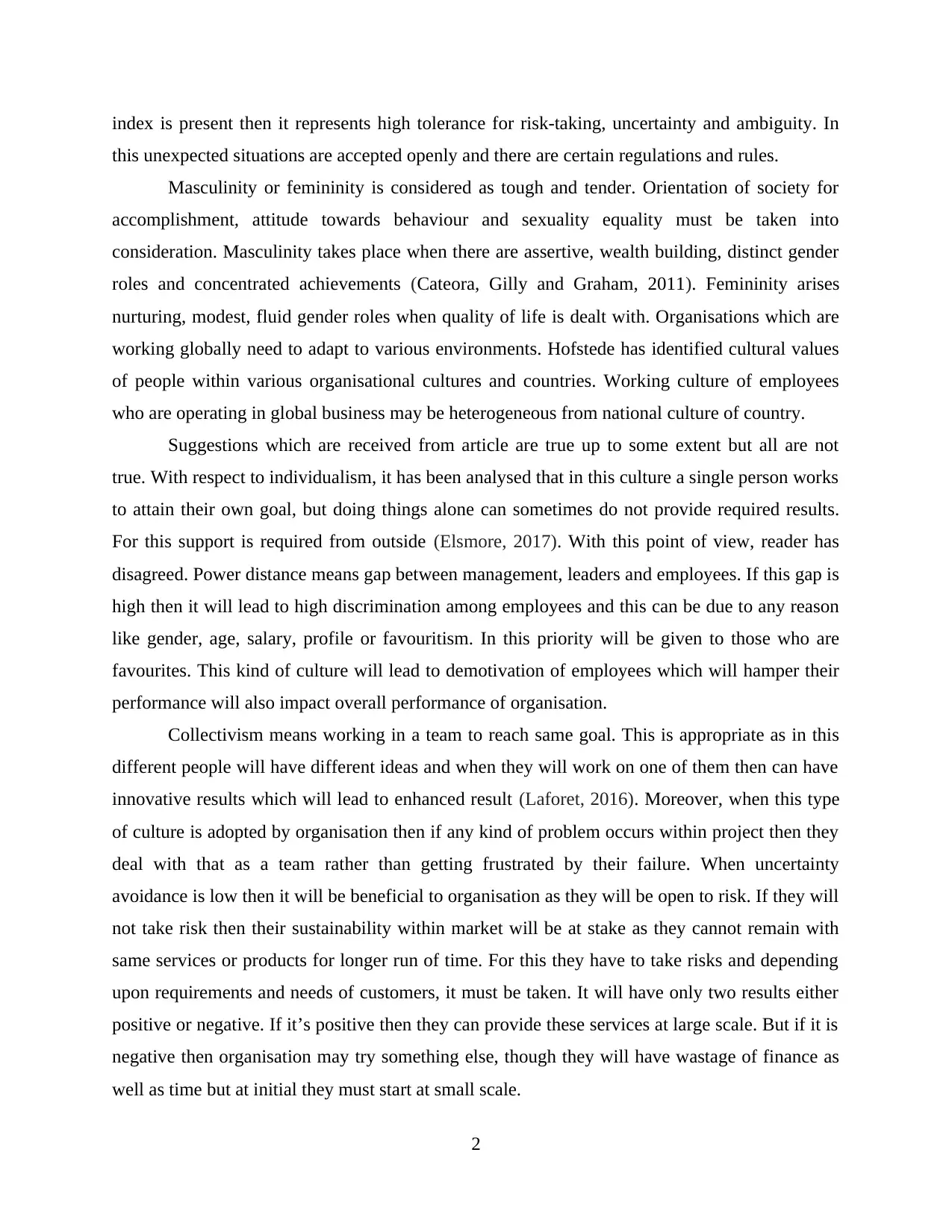
index is present then it represents high tolerance for risk-taking, uncertainty and ambiguity. In
this unexpected situations are accepted openly and there are certain regulations and rules.
Masculinity or femininity is considered as tough and tender. Orientation of society for
accomplishment, attitude towards behaviour and sexuality equality must be taken into
consideration. Masculinity takes place when there are assertive, wealth building, distinct gender
roles and concentrated achievements (Cateora, Gilly and Graham, 2011). Femininity arises
nurturing, modest, fluid gender roles when quality of life is dealt with. Organisations which are
working globally need to adapt to various environments. Hofstede has identified cultural values
of people within various organisational cultures and countries. Working culture of employees
who are operating in global business may be heterogeneous from national culture of country.
Suggestions which are received from article are true up to some extent but all are not
true. With respect to individualism, it has been analysed that in this culture a single person works
to attain their own goal, but doing things alone can sometimes do not provide required results.
For this support is required from outside (Elsmore, 2017). With this point of view, reader has
disagreed. Power distance means gap between management, leaders and employees. If this gap is
high then it will lead to high discrimination among employees and this can be due to any reason
like gender, age, salary, profile or favouritism. In this priority will be given to those who are
favourites. This kind of culture will lead to demotivation of employees which will hamper their
performance will also impact overall performance of organisation.
Collectivism means working in a team to reach same goal. This is appropriate as in this
different people will have different ideas and when they will work on one of them then can have
innovative results which will lead to enhanced result (Laforet, 2016). Moreover, when this type
of culture is adopted by organisation then if any kind of problem occurs within project then they
deal with that as a team rather than getting frustrated by their failure. When uncertainty
avoidance is low then it will be beneficial to organisation as they will be open to risk. If they will
not take risk then their sustainability within market will be at stake as they cannot remain with
same services or products for longer run of time. For this they have to take risks and depending
upon requirements and needs of customers, it must be taken. It will have only two results either
positive or negative. If it’s positive then they can provide these services at large scale. But if it is
negative then organisation may try something else, though they will have wastage of finance as
well as time but at initial they must start at small scale.
2
this unexpected situations are accepted openly and there are certain regulations and rules.
Masculinity or femininity is considered as tough and tender. Orientation of society for
accomplishment, attitude towards behaviour and sexuality equality must be taken into
consideration. Masculinity takes place when there are assertive, wealth building, distinct gender
roles and concentrated achievements (Cateora, Gilly and Graham, 2011). Femininity arises
nurturing, modest, fluid gender roles when quality of life is dealt with. Organisations which are
working globally need to adapt to various environments. Hofstede has identified cultural values
of people within various organisational cultures and countries. Working culture of employees
who are operating in global business may be heterogeneous from national culture of country.
Suggestions which are received from article are true up to some extent but all are not
true. With respect to individualism, it has been analysed that in this culture a single person works
to attain their own goal, but doing things alone can sometimes do not provide required results.
For this support is required from outside (Elsmore, 2017). With this point of view, reader has
disagreed. Power distance means gap between management, leaders and employees. If this gap is
high then it will lead to high discrimination among employees and this can be due to any reason
like gender, age, salary, profile or favouritism. In this priority will be given to those who are
favourites. This kind of culture will lead to demotivation of employees which will hamper their
performance will also impact overall performance of organisation.
Collectivism means working in a team to reach same goal. This is appropriate as in this
different people will have different ideas and when they will work on one of them then can have
innovative results which will lead to enhanced result (Laforet, 2016). Moreover, when this type
of culture is adopted by organisation then if any kind of problem occurs within project then they
deal with that as a team rather than getting frustrated by their failure. When uncertainty
avoidance is low then it will be beneficial to organisation as they will be open to risk. If they will
not take risk then their sustainability within market will be at stake as they cannot remain with
same services or products for longer run of time. For this they have to take risks and depending
upon requirements and needs of customers, it must be taken. It will have only two results either
positive or negative. If it’s positive then they can provide these services at large scale. But if it is
negative then organisation may try something else, though they will have wastage of finance as
well as time but at initial they must start at small scale.
2
Paraphrase This Document
Need a fresh take? Get an instant paraphrase of this document with our AI Paraphraser
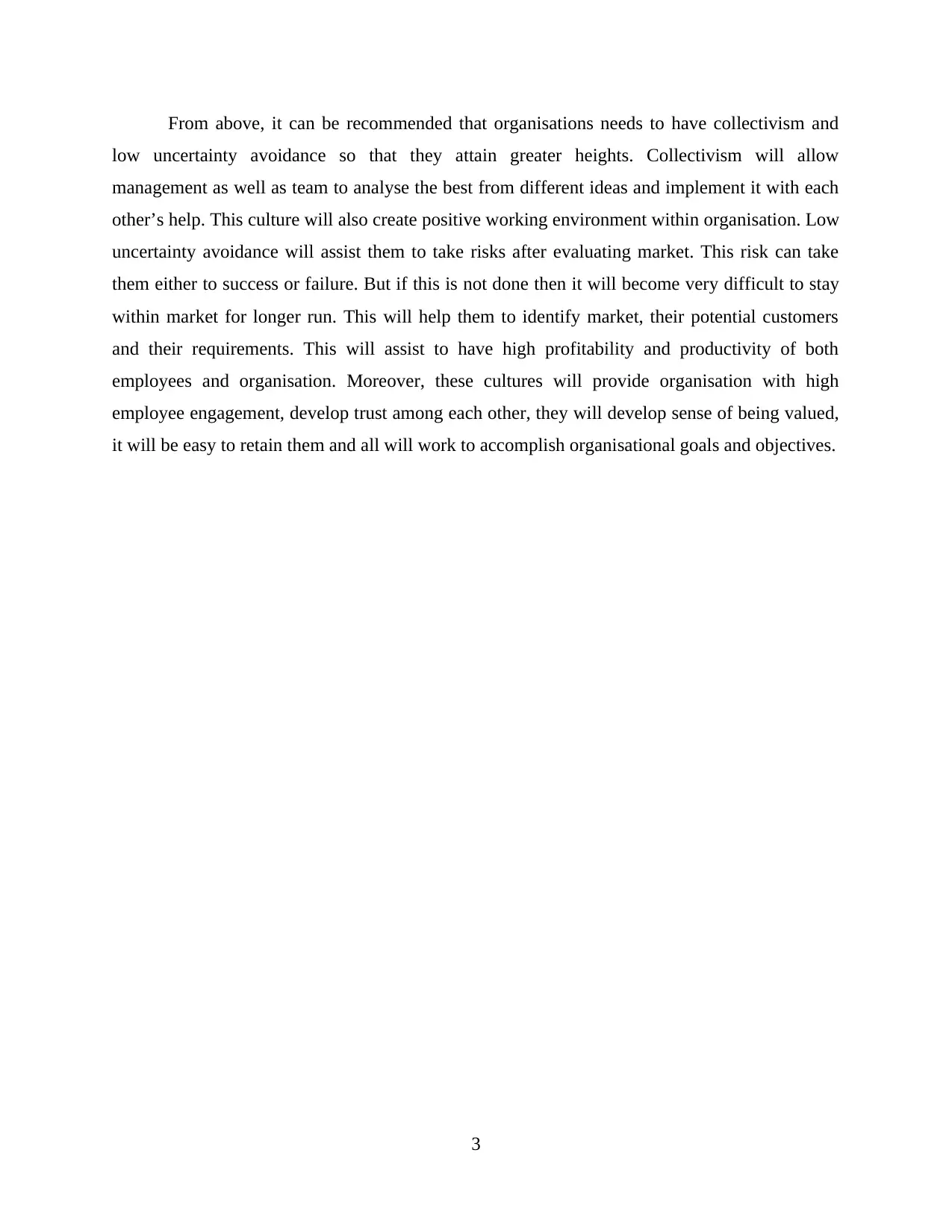
From above, it can be recommended that organisations needs to have collectivism and
low uncertainty avoidance so that they attain greater heights. Collectivism will allow
management as well as team to analyse the best from different ideas and implement it with each
other’s help. This culture will also create positive working environment within organisation. Low
uncertainty avoidance will assist them to take risks after evaluating market. This risk can take
them either to success or failure. But if this is not done then it will become very difficult to stay
within market for longer run. This will help them to identify market, their potential customers
and their requirements. This will assist to have high profitability and productivity of both
employees and organisation. Moreover, these cultures will provide organisation with high
employee engagement, develop trust among each other, they will develop sense of being valued,
it will be easy to retain them and all will work to accomplish organisational goals and objectives.
3
low uncertainty avoidance so that they attain greater heights. Collectivism will allow
management as well as team to analyse the best from different ideas and implement it with each
other’s help. This culture will also create positive working environment within organisation. Low
uncertainty avoidance will assist them to take risks after evaluating market. This risk can take
them either to success or failure. But if this is not done then it will become very difficult to stay
within market for longer run. This will help them to identify market, their potential customers
and their requirements. This will assist to have high profitability and productivity of both
employees and organisation. Moreover, these cultures will provide organisation with high
employee engagement, develop trust among each other, they will develop sense of being valued,
it will be easy to retain them and all will work to accomplish organisational goals and objectives.
3
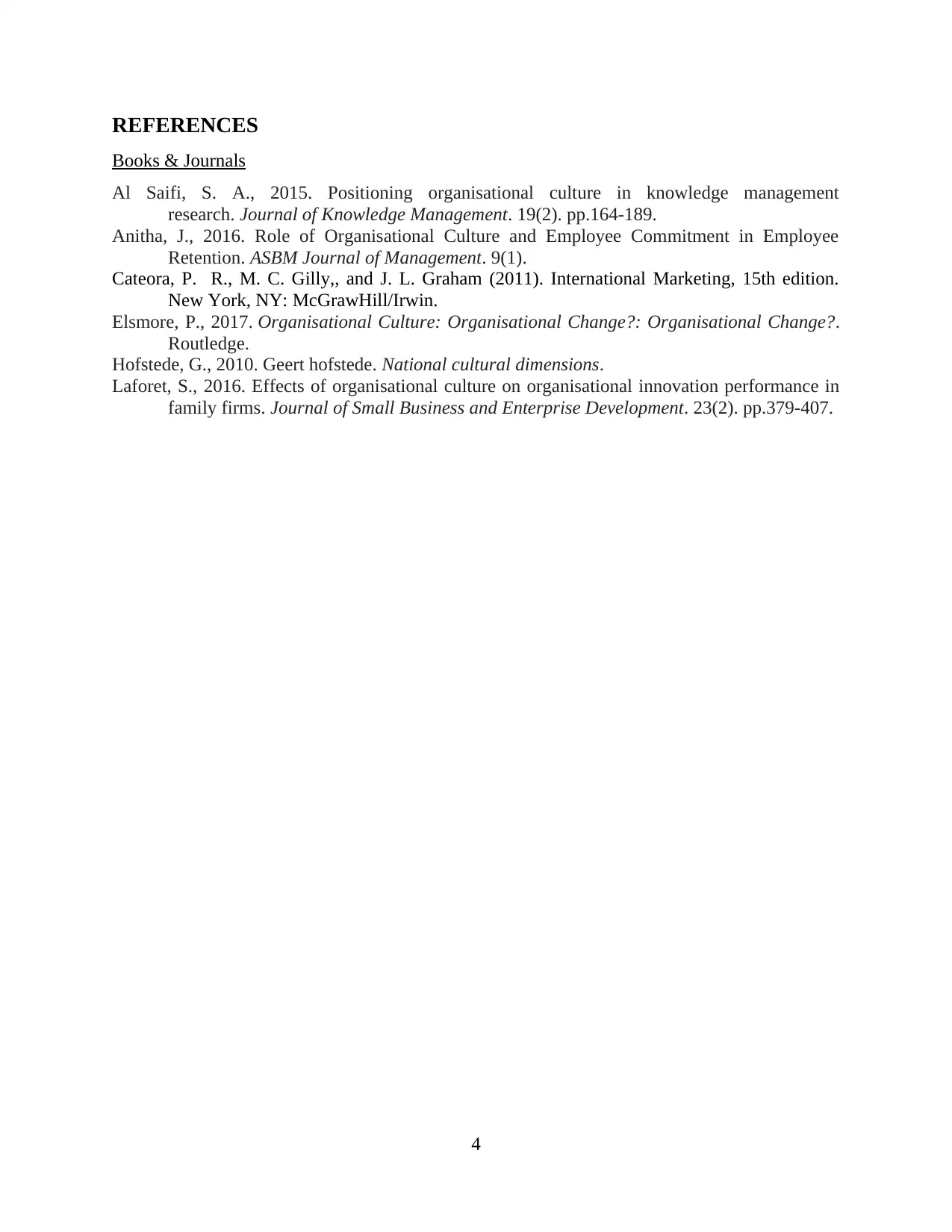
REFERENCES
Books & Journals
Al Saifi, S. A., 2015. Positioning organisational culture in knowledge management
research. Journal of Knowledge Management. 19(2). pp.164-189.
Anitha, J., 2016. Role of Organisational Culture and Employee Commitment in Employee
Retention. ASBM Journal of Management. 9(1).
Cateora, P. R., M. C. Gilly,, and J. L. Graham (2011). International Marketing, 15th edition.
New York, NY: McGrawHill/Irwin.
Elsmore, P., 2017. Organisational Culture: Organisational Change?: Organisational Change?.
Routledge.
Hofstede, G., 2010. Geert hofstede. National cultural dimensions.
Laforet, S., 2016. Effects of organisational culture on organisational innovation performance in
family firms. Journal of Small Business and Enterprise Development. 23(2). pp.379-407.
4
Books & Journals
Al Saifi, S. A., 2015. Positioning organisational culture in knowledge management
research. Journal of Knowledge Management. 19(2). pp.164-189.
Anitha, J., 2016. Role of Organisational Culture and Employee Commitment in Employee
Retention. ASBM Journal of Management. 9(1).
Cateora, P. R., M. C. Gilly,, and J. L. Graham (2011). International Marketing, 15th edition.
New York, NY: McGrawHill/Irwin.
Elsmore, P., 2017. Organisational Culture: Organisational Change?: Organisational Change?.
Routledge.
Hofstede, G., 2010. Geert hofstede. National cultural dimensions.
Laforet, S., 2016. Effects of organisational culture on organisational innovation performance in
family firms. Journal of Small Business and Enterprise Development. 23(2). pp.379-407.
4
⊘ This is a preview!⊘
Do you want full access?
Subscribe today to unlock all pages.

Trusted by 1+ million students worldwide
1 out of 6
Related Documents
Your All-in-One AI-Powered Toolkit for Academic Success.
+13062052269
info@desklib.com
Available 24*7 on WhatsApp / Email
![[object Object]](/_next/static/media/star-bottom.7253800d.svg)
Unlock your academic potential
Copyright © 2020–2025 A2Z Services. All Rights Reserved. Developed and managed by ZUCOL.




